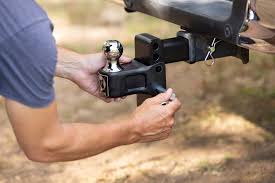So you’re ready to tow something—maybe it’s a boat for the weekend, a trailer for your next big move, or your buddy’s “project car” (you know, the one that’s been a project for 7 years). Whatever it is, before you hook it up and hit the road, there’s one super important thing you need to know:
Can your hitch handle it?
Knowing your hitch rating could be the difference between a smooth tow and a total disaster. So let’s break it down—and make it fun while we’re at it.
What’s a Hitch Rating, Anyway?
Think of your hitch like a pair of jeans. Sure, you might be able to squeeze into your high school size, but that doesn’t mean you should. Every hitch is built to carry a certain amount of weight. Go over that number, and things are going to get real uncomfortable—real fast.
Hitch ratings tell you two key things:
- Gross Trailer Weight (GTW): The total weight your hitch can pull.
- Tongue Weight (TW): The amount of weight pushing down on your hitch from the trailer connection.
If either number is too high, you’re flirting with a towing horror story.
Step 1: Peek Under the Bumper
Most hitches have a label or metal plate with the important info. Crawl under there (carefully!) and look for numbers like:
- GTW – Gross Trailer Weight
- TW – Tongue Weight
- Class – Ranges from I (light stuff like a bike rack) to V (big boys towing boats, horses, or tiny houses)
Here’s a quick cheat sheet:
- Class I: Up to 2,000 lbs
- Class II: Up to 3,500 lbs
- Class III: Up to 6,000 lbs
- Class IV: Up to 10,000 lbs
- Class V: Up to 20,000+ lbs (aka “I’m basically a semi truck”)
Step 2: Check Your Vehicle’s Towing Capacity
Now for the plot twist: your hitch might be rated high, but your vehicle might not be. That’s like having a giant ice cream sundae… and a lactose intolerance.
Open your owner’s manual or Google your car’s make and model + “towing capacity.” Look for:
- Max towing weight
- Max tongue weight
(And yes, that includes passengers, luggage, and your dog riding shotgun.)
Step 3: Don’t Forget the Hitch Ball
That shiny ball on your hitch? It’s not just for looks. It has its own weight rating stamped on top. Make sure it can handle the load too—otherwise, your trailer could go rogue. (Yikes.)
Don’t Let the Ball Be the Weak Link
Here’s something a lot of folks miss: your towing setup is only as strong as its weakest component—and that’s often the ball.
Even if your hitch says it can handle 10,000 lbs and your vehicle can tow 8,000 lbs, if your ball is only rated for 5,000 lbs… that’s your limit. Period. No exceptions.
Think of it like a chain—if one link snaps, the whole thing fails. Always go by the lowest-rated part in your towing system. That means:
Ball weight rating = your actual towing limit
(Even if the car and hitch could do more.)
So before you haul anything, check the rating stamped on the ball and make sure it matches (or exceeds) what you’re towing. Safety first, tailgate party second.
Towing Shouldn’t Be a Gamble
Don’t eyeball it. Don’t guess. Check your hitch, your vehicle, your ball, and your trailer. Every part of your setup needs to be in sync—like a boy band, but with steel and torque.
So next time you hear someone say, “It’ll probably be fine,” smile politely… and go check your hitch rating anyway. We’ll be happy to help get you hooked up safely!
Happy towing!

